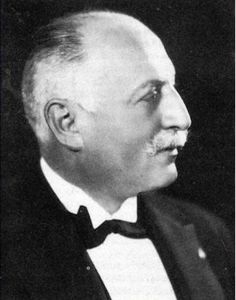The Engineer
 The engineer and podestà Pietro Agosti was born in Bordighera on 1st April 1873.
The engineer and podestà Pietro Agosti was born in Bordighera on 1st April 1873.
His father Giuseppe, born in the province of Alessandria, and since he was employed by the railways, was transferred to Bordighera where he met his wife, Caterina Amoretti, Pietro's mother.
In the following years, his father was transferred to Ospedaletti following his promotion to stationmaster, and so Pietro moved there with his family.
After graduating in civil engineering on 3 September 1896, Pietro inaugurated his career with the reconstruction of the church of Bussana Nuova (which he faced after the death of the first architect, Maurizio Dufour), of which he executed both the main portal and the tomb of Don Lombardi.
The following year he designed the Hotel de Paris, the first work carried out in the city of Sanremo, and in 1899 the Hotel Savoy, inspired by the typical models of the Côte d'Azur, but also by the teaching of the acclaimed Sanremo architect Pio Soli, devoted more to neo-Renaissance architecture.
He is considered the initiator of the third generation of Sanremo architects of the early twentieth century, who moved from the original eclecticism, Art Nouveau and Deco, towards rationalist design.
Agosti was an accurate and attentive designer, meticulous and careful of details, so much so that when he dedicated himself in 1902 to Palazzo Asquasciati and to the renovation, in 1903, of Villa Gandolfi (today Villa Magnolie), he wanted to personally take care of all the decorative details, following rigorous classical models.
In 1904 he became a member of the College of Engineers and Architects of Genoa. In the meantime his fame began to spread, so much so that he also received commissions from the numerous foreign guests of Sanremo: to this end, he also studied the architectural models of Northern Europe. In this specific case, with the Devachan Castle (designed for the Countess of Mexbourough, Silvia Clark, in 1905, and completed in 1909) he introduced the rustication typical of the simplest English architecture. It was also in this period that he began his political activity: he became a town councillor from 1908 to 1913.
In 1925 he produced the first two planimetric reliefs of the Roman ruins of the ancient Villa Matutia located in Sanremo, thus providing the oldest documentation of the archaeological site and also accompanied it with some photographs.
The Ligurian city still preserves many of its other designs or renovations, including Villa Ines and Villa Sunnybank (1905), the Hotel Méditerranée (1906), Villa Perla, and the exterior design of the Cinema Centrale (1928), with déco-style decorations.
He also dedicated himself to the Russian Church in 1912, a small local masterpiece that was an expression of all the architect's imagination and graphic skill. With the Villa Spinola (later Hotel King, currently being renovated after a devastating fire that half destroyed it in the last eighties) he re-proposed the double rusticated wall face of the Devachan Castle, while in the attics, finely decorated, and in the marble decorations he reproduced the rich model of the city's architecture of the time.
In addition to all the rest, the project of the Casa del Bambino (Pro Infantia) of 1927 and the schools in Via Volta of 1928, completed by Giovenale Gastaldi in 1935, remain from the podestariale period.
He died suicidal on 29 April 1930.
To learn more about the life of Pietro Agosti see Pietro Agosti Podestà.
(Information text freely taken from Wikipedia)




